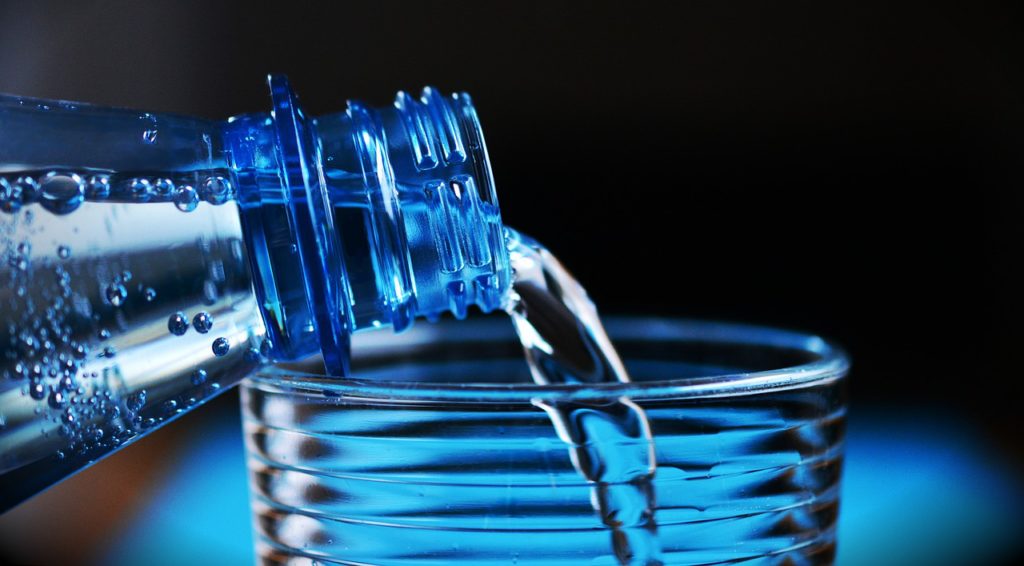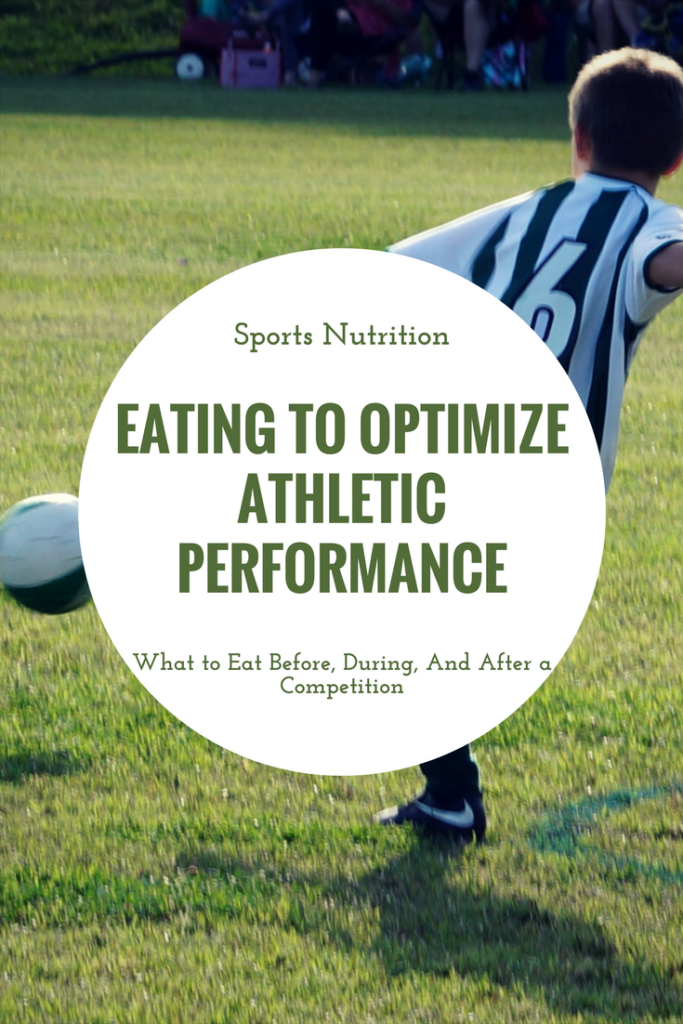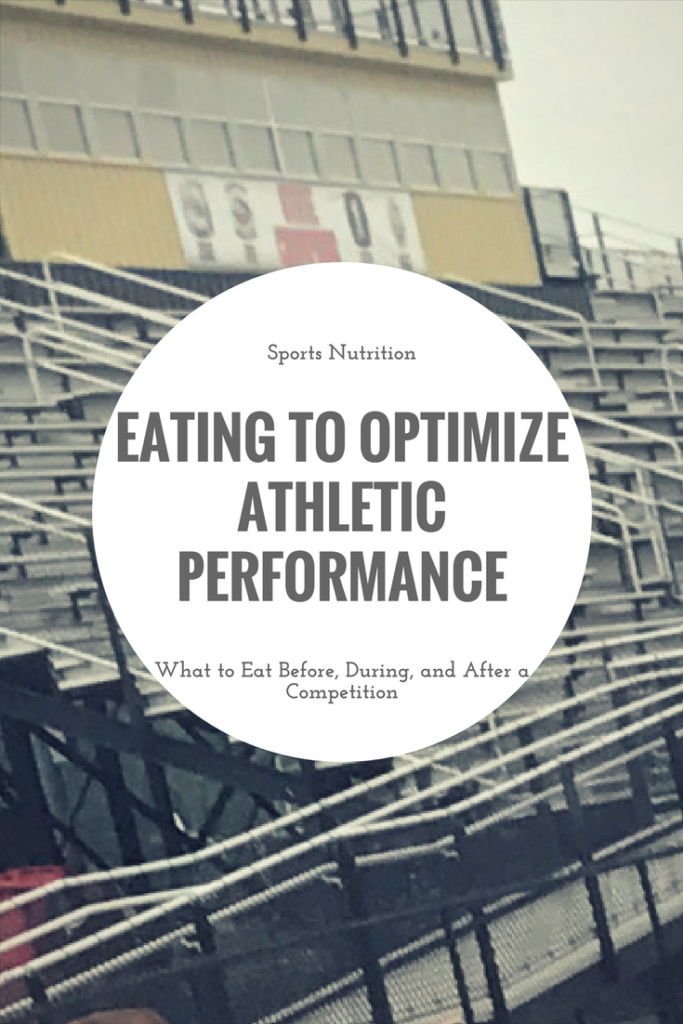Sports Nutrition-
Eating to Optimize Athletic Performance:
Disclosure: This site may provide affiliate links (See full disclosure)
What to Eat Before, During, and After a Performance, Game, or Competition
The Meal Before an Athletic Performance
The goal of the pre-exercise meal is to maximize glycogen stores (which is the sotrage form of readily available energy), provide adequate hydration, minimize hunger, and minimize any undigested foods that can lead to GI distress. In order to meet these goals, the pre-game meal should occur 2 to 4 hours before the game/performance.
The pre-game meal should be high in carbohydrates; that is 60 to 70% of the calories from that meal should be from carbohydrates. A high carbohydrate diet is needed to maintain glycogen stores and blood glucose. Muscle glycogen is used for energy during exercise, and liver glycogen stores are used to maintain stable blood glucose levels during the athletic performance.
The pre-game meal should be moderate in protein. Only 10 to 25% of the calories in the meal should be from protein foods.
Finally, the pre-game meal should be low in fat, low in fiber, low in spicy foods, and low in simple sugars. Meals high in fiber may cause GI distress during a game.
Pre-Game Meal: Quick Reference
- Eaten 2 to 4 hours before the performance
- High Carbohydrate (60 to 70% of total calories)
- Moderate in protein (10 to 25% of total calories)
- Low in fat, spicy foods, simple sugars, and fiber (To prevent GI distress)
Pre-game meal examples:
- 1 cup of pasta, spaghetti, or rice and tomato sauce
- Turkey sandwich and pretzels
The “Meal” During an Athletic Performance
The most crucial essential nutrient during a performance is water so be sure to HYDRATE during the game. You should take 3 to 4 sips of water every 15 minutes. If the performance last for more than one hour, you should consume 30 to 60 grams of carbohydrates to enhance endurance, and drink a beverage containing sodium.
Examples of “during performance carbohydrate snacks” are a banana (also a good source of electrolyte, potassium) or an energy bar like the CLIF BAR – Energy Bar – Chocolate Chip – (2.4 Ounce Protein Bar, 12 Count) Each Clif bars contains the important carbohydrates and electrolytes needed for longer performances. You can also get both the sodium and carbohydrates needed by drinking a sports drink like Powerade Sports Drink Variety Pack (20 oz. bottles, 24 ct.)
or BodyArmor SuperDrink, Variety pack – 7 flavors – Including Jummybo mints
If the performance last MORE THAN 3 HOURS, drink an electrolyte containing drink. Drinks like Powerade, Gatorade, and BodyArmor not only contain water, carbohydrates, and sodium, but also contain other electrolytes as well. These drinks will also work well for performances lasting longer than 3 hours. When exercising for an extended period like in a marathon, consume carbohydrates such as bananas, gel packs like PowerBar, Performance Energy Gel, Strawberry Banana Flavor, 24 Gel Packs, 1.44 oz or energy bars like Clif bars every 15 to 20 minutes. You can find Clif Bars by clicking on the following link. CLIF ENERGY BAR – Value Pack – Chocolate Chip and Crunchy Peanut Butter – (2.4 oz, 6 Count, 6 Pack)
Why is Salt Intake During an Athletic Performance so Important?
When you are exercising for an hour or less, plain water is recommended. However, if you are in an athletic competition for over an hour, you should begin replenishing your electrolytes, especially your sodium content. When we sweat, we lose water AND salt. We know that lack of water can be dangerous so we often make sure we are drinking plenty of water during an athletic performance. However when you replenish the water in your body WITHOUT replenishing the salt in your body, the sodium content in your body becomes diluted. In other words, the sodium to water ratio becomes out of balance. So the problem is not only that you lost sodium in your sweat, but that the sodium-to-water ratio becomes out of balance as you drink more and more water. This is called hyponatremia.
Unfortunately symptoms of hyponatremia are similar to symptoms of dehydration so someone may think they are dehydrated and drink more water when in fact they are actually experiencing symptoms of hyponatremia. Drinking more water WITHOUT sodium makes the hyponatremia worse. Symptoms of hyponatremia includes dizziness, lethargy, thirst, headache, nausea, cramps, irritability, and in severe cases even coma and death. Notice the similarity of the symptoms to the symptoms of dehydration. The take home message is that water is crucial! We should drink water throughout any athletic event no matter how long the event. However, if the athletic even is over an hour, we should also drink a sports drink that contains water AND electrolytes.
During Performance Meal: Quick Reference
- HYDRATE
- Consume 30 to 60 grams of carbohydrates and drink a liquid containing sodium if the performance last for more than one hour to enhance endurance. Example: a banana or energy bar like a Clif bar
- You can get the needed carbohydrates, water, and electrolytes in drinks like Powerade or Allsport.
- Drink electrolyte drinks if you will be exercising for more than 3 hours; Examples: Powerade, Gatorade, or BodyArmor (These are carbohydrate sources as well)
- When exercising for extended period of time (marathon): Consume CHO every 15 to 20 minutes. Ex: Gel packs and energy bars like Powebar or Clif bar
* Put simply, drink 3-4 sips of water every 15 minutes if you are exercising for less than an hour. If you are performing for more than an hour drink an electrolyte and carbohydrate drink like BodyArmor SuperDrink, Variety pack – 7 flavors – Including Jummybo mints or Powerade Sports Drink Variety Pack (20 oz. bottles, 24 ct.)
. If you are performing for greater than 3 hours, drink an electrolyte and carbohydrate drink and consume a carbohydrate snack/drink every 15 to 20 minutes.
The Meal After Performance, BUT NOT Performing the Next Day
During exercise, the body is breaking down glycogen, triglycerides, and muscle protein for energy; therefore, the body must restore muscle, glycogen, and lipids after the performance. The meal simply needs to be a normal healthy meal. One fourth of the meal should consist of healthy whole grains, one fourth of the meal should contain lean meats, and half of the meal should contain fruits and vegetables. Note this is the after performance meal when you do NOT have a performance the next day. However, the recommendations are slightly different if you are performing two days in a row.
After Game Meal, But NOT Performing the Next Day: Quick Reference
- Hydrate
- Normal Healthy Meal
The Meal After A Performance IF Performing AGAIN the Next Day
If you have finished an athletic performance, and are performing again the next day, your after performance meal should take place within 30 minutes after you have finished competing. The number one priority should be replacing fluid loss.
The meal should also be high in carbohydrates. A high carbohydrate meal is needed to replace glycogen stores. If you do not replace the glycogen stores, your body will use muscle protein to replace the stores. Many think that eating high protein is crucial to replace or build muscle after a performance; however, you need to make sure you are getting enough carbohydrates as well. If your body does not have enough glycogen (carbohydrate stores); then your body is going to get glycogen by breaking down your muscles! You should eat 1 to 1.5 grams of carbohydrates per kg body weight every two hours for 6 hours! So if a person weighs 150 pounds, they could eat about 1.5 cups of pasta every 2 hours for 6 hours. So they would eat 1.5 cups of pasta three times in six hours for a total of 4.5 cups of pasta in six hours. Remember, you do not need to eat every 2 hours unless you are performing the next day. This is to build up your depleted glycogen store before your next day performance.
The Meal After a Performance IF Perfoming AGAIN the Next Day: Quick Reference
- #1 priority: replace fluid loss
- High CHO: replaces glycogen; if you do not replace glycogen, your body will use muscle protein;
- Eat 1 to 1.5 grams of CHO per kg body wt, every 2 hours for 6 hours.
You are free to retain any and all content here for personal use, but need permission to use it anywhere else on the internet.




Thank you for sharing this. I am about to get back into running and I needed a refresher.
I am so glad you found this post a helpful refresher. Happy running!
These are great tips to make sure you or someone in your family doesn’t have to worry about dehydration. Performing can be stressful enough without having to worry what to eat and how much to drink.
So true! So much to think about when you are an athlete in a competition.
This is such a comprehensive resource, Lacy! Definitely saving to pass along to the athletes I work with!
I am so glad you found it a helpful resource for the athletes you work with! Thanks for sharing!
Very helpful post! Love learning about sports nutrition!
Thanks Emily!
This is all great advice, and spot-on with what I learned as a college athlete and later, as an adult, training for my first century ride. It’s also a good reminder that just because I bike 40, 65, or 100 miles on a given day doesn’t give me a free pass to pig out on lots of junk afterward 🙂 …
Congrats on training for your first century ride. That is awesome!
this is an awesome post!
I learned so many things that I had no idea about!
i love this!
Oh I am so glad you found this helpful. Thanksfor taking hte time to comment!
This is such a hot topic, now with fitness blowing up on social media. Thanks for your detailed insights!
Thanks Jodi!
Really good tips! I appreciate these even as someone who is not an avid gym goer or athlete, but as someone who just likes to generally stay healthy and active.
Thanks Mary Leigh!
Hi, I found your post from Dietitians on the Blog. Great post!! I’m a fitness enthusiast too. This is an odd question, but what is your name? I couldn’t find it in your About Me (and some tips). I specialize in diabetes and weight loss. I think you are doing a great job, and am excited to network with you.
Hi Ariel, I should probably makes sure my name is easier to find on my website. Thanks for commenting. My name is Lacy Ngo, MS RD. Thanks for reaching out!
Great tips! I need to remember this on my kidsge days!
Thanks Claire!